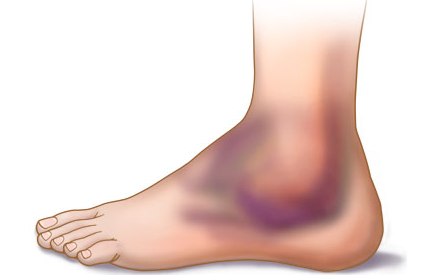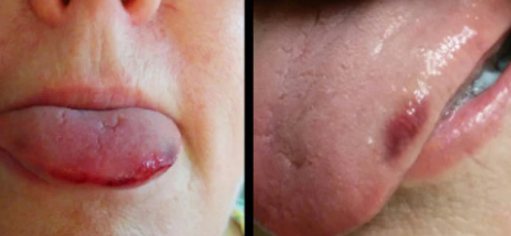Getting a bruise and swelling of the ankle is easy especially when one engages in sports. You can experience badly bruised ankle from running. This could manifest itself in sprained or swollen ankle. The symptoms and having the knowledge to heal as well as how to treat a bruised ankle is important as it will help ensure a quick recovery.

Bruised Ankle Symptoms
What are the common symptoms of a bruised ankle?
Here is how you can tell if your ankle is bruised. Among the most common bruised ankle symptoms include: stiffness, pain and at times stiffness in the joint. A bruised ankle’s severity is rated from mild to severe. The injury leading to the bruise is what determines this.
The symptoms may be so severe that walking and running becomes extremely painful. Where it is severe the ankle joint may become unstable.
For a Badly Bruised Ankle from Running, do the following:
Understand this, the ankle is what joins the leg and the foot. It is full of ligaments, muscles, tendons and bones. The ligaments are what help keep the bones stable. The bones on the other hand are attached to the muscles through the tendons. When any part of these components is injured as a result of excessive strain or stretching, the result is a bruised ankle.
Here is what could lead to injury or bruises on your ankle:
- Jumping
- A bad fall
- Ill fitting shoes
- Twisting of the joint which could happen when running
What to do:
Rest
Having outlined the possible causes of bruising or injuries the next question is how to deal with it. It is recommended by most health practitioners to take one complete rest to enhance fast recovery. When the bruised ankle is relaxed, it helps to reduce the symptoms. On the other hand, further stress tends to aggravate pain as well as make the condition worse.
Apply ice packs
Icing or applying ice packs on the affected ankle is one of the surest to remedy. This is how to do it.
Within the first 24 hours of bruising, one should ice the ankle.
- Apply the ice packs for about 15minutes in every hour.
- Wrap some ice in a piece of cloth and apply it on the bruise. Icing helps in reducing inflammation, swelling and pain.
- Keeping the bruised ankle elevated could also help in reducing swelling as well as preventing blood from pooling around the injured area.
Your doctor should also talk about braces. These help in allowing for free movement.
Massage the bruised area
Massaging the bruised area as well as physiotherapy exercises on the affected area could as well help in quick recovery. Where the injury was serious enough to cause ligament tear, one will be required to undergo ligament tear. To cure soreness on the bruise, minimal movement is encouraged. This helps in reducing strain brought about by the body’s weight.
With proper care, a bruised ankle should take between four to six weeks to be completely healed. One ought to take good care of themselves before they can resume sporting activities. Strengthening exercise is important in helping to improve the flexibility and strength of the ankle. Ensure shoes worn are well fitting to ensure ample cushioning and avoid recurrence and avoid pressuring the bruised area.
Swollen Bruised Ankle
Having a swollen bruised ankle can be as a result of localized extremities or diseases and other conditions affecting the whole body. Localized infections or injuries lead to a swollen ankle on the specific part involved. This mostly results from strains and sprains.
Condition or diseases such as liver failure, heart disease, kidney failure or edema could be the cause of your swollen bruised ankle. Not only is the ankle affected but also the feet and legs as well. It is quite possible for this to occur in pregnancy, when one is obese and in case on is suffering from an obstruction in the venous system. Other diseases that can affect the ankle include arthritis.
Treatment for a swollen bruise on the ankle will depend on its cause. To manage the swelling and the pain, anti-inflammatory medicine can be used. This is more so where the bruising is as a result of sprains.
Bruised Sprained Ankle
As mentioned earlier in the post, ligaments are strong structures that are band like and are found around the joints that attach bones together. A sprain tends to be an injury to the ligaments. A bruised sprained ankle normally occurs when the ligaments get overstretched in a sudden pull. In this case the ligaments on the ankle’s side are most vulnerable to sprains.
A sprain and or a bruise, your ligaments will be the most likely to suffer the damage enough to cause swelling, inflammation and bleeding which shows up as a bruise. Pain becomes inevitable where the bruising is extensive.
Depending on the severity, how bad the stretching of the ligaments is and whether the ankle has been destabilized. The joint becomes unstable when damage done to the ligaments renders them incapable of giving normal support. These include mild stretching, partial rupture and a complete rupture which is most severe.
How to Heal a Bruised Ankle
We’ve mentioned in the post, how to deal with a bruised or an injured ankle. Just to put you up to speed. You should first:
- Take a rest- reduce movement as much as possible
- Apply ice packs on the affected area
- Warm compress
- Massaging can also help to reduce swelling
- Elevating the bruised ankle
While dealing with how to heal a bruised ankle, the acronym PRINCE is used. This refers to: protection, rest, non–steroidal anti-inflammatory drugs, compression as well as elevation. To heal a bruised ankle, taking enough rest. Ensure that movement is reduce. This will ensure that it is protected from aggravation of the damage. Constantly and consistently ice the affected area. This should be done 3 – 4 times daily.
Warm compress can also keep the swelling down. A compression bandage, which looks like a sock that has a hole at the heel, could also help. Ace braces could also come in handy in preventing movement of the ankle which will help in healing the bruises. The leg should also be kept elevated to prevent blood from pooling around the bruise.
Just in case after one week or so the swelling keeps increasing and you experience severe pain, it is time to see the doctor. The doctor will examine the ankle and advise on how best to treat it. Also watch out for infections and see a doctor immediately if some is noticed.
How to Treat a Bruised Ankle
Any form of bruising can be treated using home remedies or by visiting the doctor. If one gets a bruised ankle, there are a number of ways of treating it. Here are some of the ways on how to treat a bruised ankle. They include
- Applying of ice. This helps in soothing the soreness of the bruise as well reduce inflammation. One should wrap up some ice with a piece of cloth and apply it on the bruise several times a day.
If the pain becomes unbearable, consult a doctor. He may recommend medication found over- the- counter such as painkillers. An ankle brace should be worn if the joint is unstable. This helps to compress the joint and make movement easier. To speed recovery, massage the area twice or thrice daily to reduce the swelling and pain go down.
Treating a bruised ankle as a result of an underlying medical condition such as obesity, requires treating the condition first. You may require to lose some weight through a medical procedure or exercise. Whatever works for you! Other diseases and conditions that could be causing it ought to be treated to prevent recurrence of the bruising.
Time it takes to fully recover depends entirely on the underlying cause. A minor injury shouldn’t take more than 3 weeks to fully recover. If you try some of the remedies mentioned earlier herein, you may actually recover much faster. Only if the cause is not of a preexisting condition.
- Bone Bruise: https://www.healthline.com/health/bone-bruise
- Swelling and Bruising of the Ankle: https://www.healthlinkbc.ca/health-topics/zm2470






